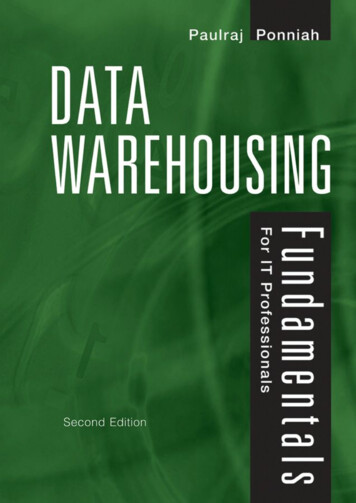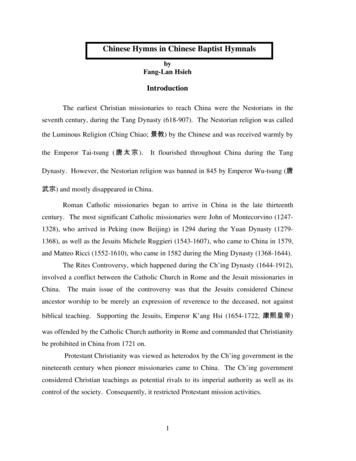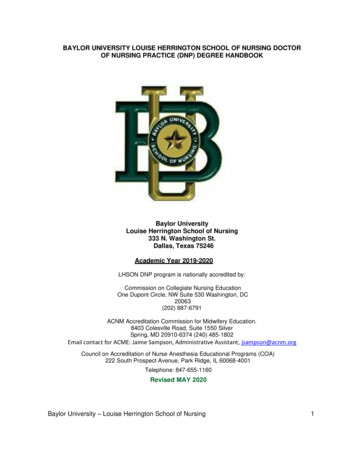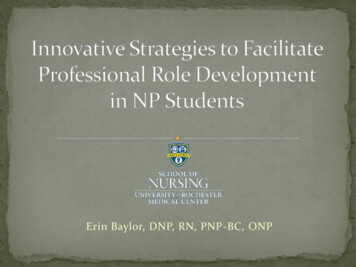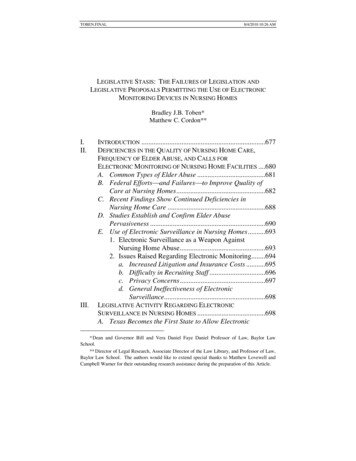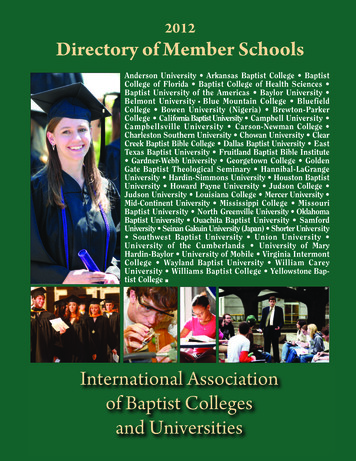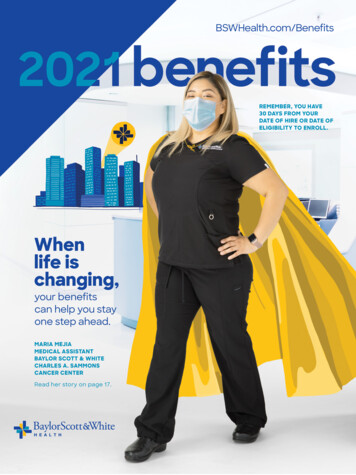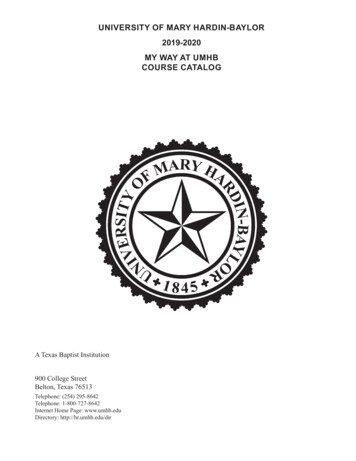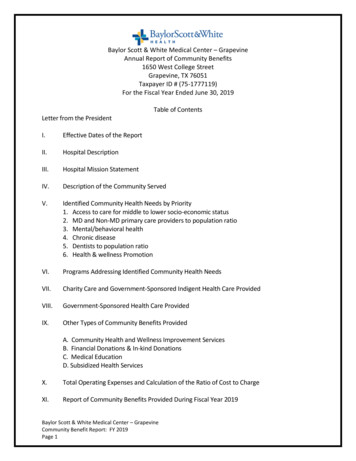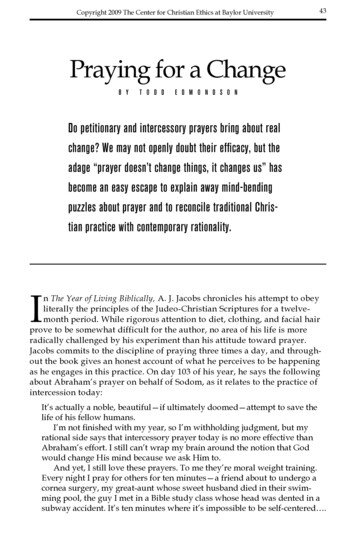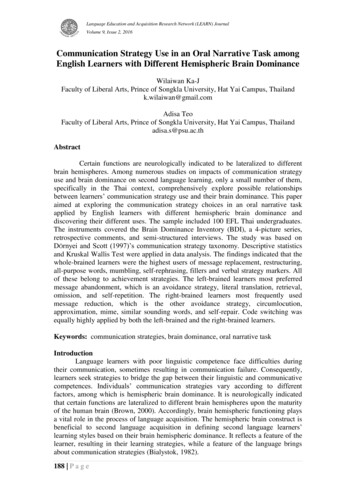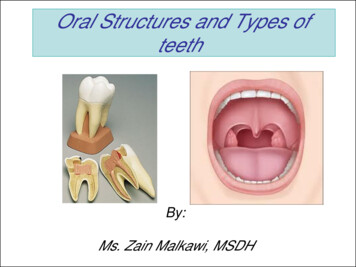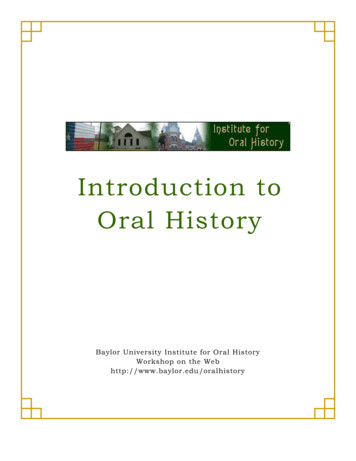
Transcription
Introduction toOral HistoryBaylor University Institute for Oral HistoryWorkshop on the Webhttp://www.baylor.edu/oralhistory
CONTENTSDiscovering oral history: What is it?Understanding oral history: Why do it?Planning a project: Where to begin?Establishing ethical relationshipsPreparing legal documentsChoosing digital recordersUsing digital mediaFocusing & researching a topicSelecting narratorsCreating an interview outlineComposing questionsInterviewing for best results:I. Making contact & setting upII. Getting the storyIII. Protecting & preserving recordingsMaking recordings accessible:I. Time coding and indexing oral historiesII. Transcribing oral historiesCritiquing & citing oral historiesReaching the public with oral history outcomesLearning more: Resources12345678910111213141516171819Copyright 2016 by BAYLOR UNIVERSITY INSTITUTE FOR ORAL HISTORYPermission is granted to download, print, or duplicate this documentfor educational purposes only.For any other use, please contact:Baylor University Institute for Oral HistoryOne Bear Place #97271Waco TX 76798-7271Phone (254) 710-3437E-mail: BUIOH@baylor.edu
Discovering oral history1Oral historyis a sound recording of historical information, obtained through an interviewthat preserves a person’s life history or eyewitness account of a past experience—but read on.In the pages that follow, this manual invites you to explore the full implications of the termsrecording, interviewing, and preserving as you learn to create oral history. Oral history recordings help listeners better understand how individuals from various viewpoints and different stations in society encountered the full range of life in their day, fromeveryday routines to catastrophic events. Carefully preserved, the recordings carry thewitness of the present into the future, where through creative programs and publications,they can inform, instruct, and inspire generations to come. Creating an oral history requires two people—one who questions and one who narrates responses to the questions. Two strengths distinguish oral history interviewing:1) subjectivity, which allows interviewers to ask not only, What happened?, but also, How didyou feel about what happened?, and 2) the partnership of co-creation, which invites narratorsto interpret and analyze their personal experiences through their own points of view and intheir own words. Preserving the recorded interview fulfills the purpose of creating the oral history in the firstplace. Preservation begins with making recordings safe, advances to making them useful andaccessible, and culminates with sharing them in creative ways with others.Oral history projectsare initiatives planned, designed, and executed by individuals orgroups to create and preserve oral histories.Oral history programscarry out oral history projects on multiple major topics or focuson one major theme. Programs may offer training and consultation services for the broadercommunity and they often partner with one another and network with other oral historiansthrough the Oral History Association and its affiliates.Oral history collectionspreserve oral histories, including the recording and accompanying derivative materials (i.e., index or transcript) and contextual materials (i.e., maps, researchnotes, correspondence, photographs, interview notes). Collections are usually administered by anarchivist within a library, museum, or historical society. Collections are accessed through acatalog record, finding aid, or digital collection Web portal and are offered to researchers in accordance with legal agreements signed by the narrators and interviewers.Oral historians come from academic settings, government offices, libraries and museums, medical andmilitary sites, community centers, families, and anywhere people are studying people andthe past;stretch beyond their immediate research needs to gather broad-based information so thattheir interviews address multiple historical questions;seek out people who may otherwise leave behind little or no material record for futuregenerations and ask questions that may have never before been asked about a topic or event;arrange ways to share the results of their interviews with narrators and their communities;deposit recordings, transcripts, and related materials in archives or libraries;produce publications and programs to distribute widely the information gained in oralhistory; andpromote professional standards for research through local, state, regional, national andinternational organizations.
2Understanding oral historyOral history helps round out the story of the past.Oral history provides a fuller, more accurate picture of the past by augmenting the information provided by public records, statistical data, photographs, maps, letters, diaries, andother historical materials. Eyewitnesses to events contribute various viewpoints andperspectives that fill in the gaps in documented history, sometimes correcting or evencontradicting the written record. Interviewers are able to ask questions left out of otherrecords and to interview people whose stories have been untold or forgotten. At times, aninterview may serve as the only source of information available about a certain place, event, orperson.Oral history helps us understand how individuals and communities experienced the forces of history.Just think of the breadth and width of history that today’s students have to learn!Traditional history courses in high school and college usually touch only on the major eventsof the past, covering the fundamentals of who, what, when, where, why, and so what. Oralhistory brings depth to our understanding of the past by carrying us into experience at anindividual level. Thoughtful, personal answers to questions like What did you do in the war?reveal the ways decisions made by the movers and shakers of the day changed the lives ofordinary people and their families and communities.Oral history teaches us what has changed and what has stayed thesame over time.Change is obvious to the eye, but oral history allows people to express the personalconsequences of change, from the simple things of life—wood stove to microwave, dial phoneto cell phone, phonograph to I-Pod—to the more complex—Yellow Dog Democrat to MoralMajority, local production to global outsourcing, country living to suburban sprawl. Duringinterviews, narrators may also reflect on ways their lives remained the same in spite ofchange, particularly in the area of values, traditions, and beliefs.Oral history preserves for future generations a sound portrait of whowe are in the present and what we remember about the past.Inevitably, future generations will view—and judge—today’s generation through the lens oftheir own experiences in their own time. The story of the past is continually revised in thelight of new interpretations. Oral history enables people to share their stories in their ownwords, with their own voices, through their own understanding of what happened and why.With careful attention to preserving our sound recordings, the voices of our narrators willendure to speak for them when they are gone. By complicating the story with individualexperience, oral histories will help future historians avoid sweeping generalizations that stereotype people, engender prejudice, and overlook important variables in the historicalcontext.
Planning a project3Oral history projects may be carried out by one person or by a group of people and may resultin a collection of interviews with an individual or with several people. At the outset of yourproject, ask yourself the following questions.Why is the oral history project needed? Determine what information you are seeking, what information you already know about thetopic, and what information is yet unknown.Make sure that oral history is the best way to gather the information you seek. Are therepeople you can reach who can and will tell you what you want to know?Seek advice on your research idea from persons with various viewpoints on the topic. Askthem to help you refine your topic, uncover background information, and locate persons tointerview.What are the goals & priorities of the project? Make it a goal to achieve the best possible recording under the most favorable conditions sothat the interview can be duplicated and distributed and, as needed, upgraded to newformats.Determine what will happen to your recordings when they are done.Decide what you will do with the information you uncover through interviews.Create lists of persons able to provide recollections appropriate to your topic.Set target dates for completion of research, interviews, processing, and programming.Prepare to be flexible; oral history takes time!What guidelines will the project follow? Develop legal forms to govern the interviews and additional donated materials, such asphotographs. This step requires choosing who will hold copyright for the interview.Talk to the archivist of the depository to which you will donate your project. Ask whatrecording formats the depository accepts, what legal agreements are required, and whataccompanying materials may be helpful (photographs, maps, interview notes, researchmaterials, word lists, transcripts, indexes, et cetera). Ask how the archives will maintainthe oral history and make it accessible to the public.Choose equipment that will best serve the project goals. Determine who funds, purchases,owns, uses, and maintains the equipment.Become familiar with the general principles and best practices of the Oral History Association.(Available at actices/.)Who will do what for the project? Fit individual skills and interests to the variety of tasks available: project director, researcher,interviewer, transcriber, and editor. Additional staff might include a photographer, videographer, archivist, equipment expert, Web designer, and fund raiser.Train staff or volunteers to produce and preserve professional quality oral histories.Plan regular meetings to assess progress toward goals.What financial resources are available? Develop a budget based on your circumstances and stick by it.In addition to personnel costs, include funds for equipment, recording media, processingand storage, record-keeping, travel, publicity, and program production.Seek sources for support locally or through grants.
4Establishing ethical relationshipsOral history is person-centered research. The creation of a recorded interview is a partnershipbetween the narrator and interviewer. To succeed, the oral history partnership requiresmutual respect and trust. With careful attention to the following matters, interviewers will gofar toward establishing rapport with their narrators and making the oral history experiencemutually rewarding.Informed consent Explain to narrators their rights and interests in the recordings and the information theywill share in the interview. Reveal to narrators the purposes of the interviews and the goals of the project. Explain the procedures that will be used during and after the interview, including howthe recording will be processed, where recordings and transcripts will be deposited, andpotential uses of the memoir.Long-range outlook Commit to producing the highest-quality interview possible. The useful life of the interview extends far beyond today, so strive to gather informationthat will be relevant to future users. You may be the only person who records your narrators’ stories, so take time to includetheir memories on subjects beyond your own immediate interests. Make every effort to place completed interviews in an archives where they can be preserved for the future and used by other interested researchers.Relationships & reputations Be sensitive to real and perceived differences between you and your narrator (age, gender, race, class, educational level, nationality, religion, et cetera) and take care not toreinforce thoughtless stereotypes. Respect the privacy of the individuals and communities from which you collect oralhistories and avoid bringing them undue notoriety. Make your interviews accessible to your narrators and their communities.Correct representation of meaning Give narrators the opportunity to respond to questions as freely as possible. Do not subject narrators to biased assumptions. Give narrators the opportunity to review transcripts created from the recordings andprovide corrections as needed.The Oral History Association sets the standards for interviewers to follow in establishingand maintaining ethical relationships with narrators, the public,and the oral history profession in itsPrinciples and Best Practices for Oral History.The latest edition of the guidelines is available online practices/.
Preparing legal documents5Narrators must give you written permission to record, reproduce, or distribute their words. Withthe storyteller’s permission, an interview with an eyewitness to history can become a primary document that provides significant historical information for years—and hopefully, generations—tocome. Every oral history legal-release form should address at least the following matters.Donor agreementThrough a contract or deed of gift, narrators agree to donate their interviews to the interviewer, the interviewer’s sponsoring organization, or the designated depository. Specific language indicates whether the donor agreement is a contract or a deed of gift. Ask your chosen oralhistory depository what type of donor agreement it prefers.Copyright assignmentOral history interviews produced in the US are subject to US copyright law, which protectsfair use of the interview in reproduction, distribution, display, public performance, and the creation of derivative works. Before an interview is recorded, duplicated, transcribed or indexed, madepublic as an audio file or transcript, quoted in a publication or broadcast, or deposit
recording, interviewing, and preserving as you learn to create oral history. Oral history recordings help listeners better understand how individuals from various view-points and different stations in society encountered the full range of life in their day, from everyday routines to catastrophic events. Carefully preserved, the recordings carry the witness of the present into the future, where .
